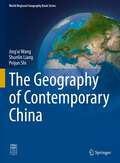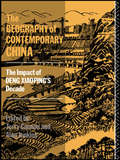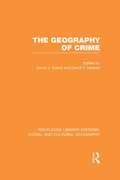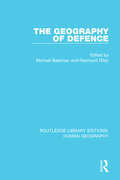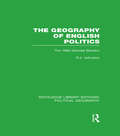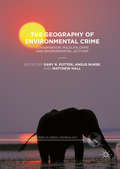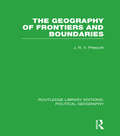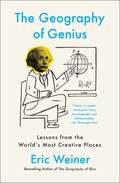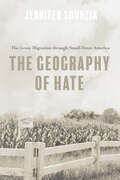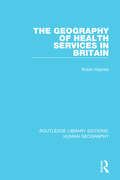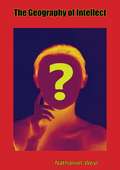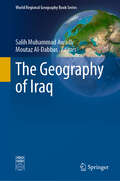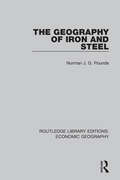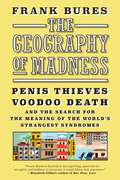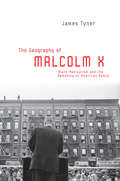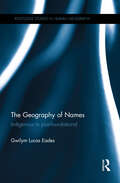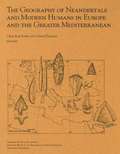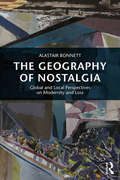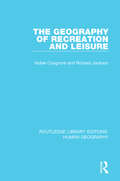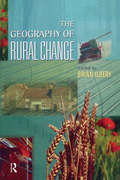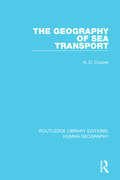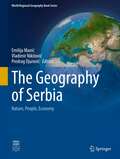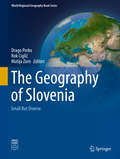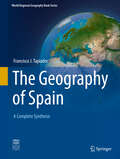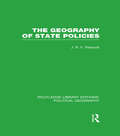- Table View
- List View
The Geography of Contemporary China (World Regional Geography Book Series)
by Peijun Shi Shunlin Liang Jing’ai WangThis textbook provides a comprehensive and very detailed insight into Chinese Contemporary Geography in English. It documents the geographical issues associated with China's rapid growth. Since initiating the reforms and open policy, China has achieved tremendous success. China's rapid growth is now a driving force in the global economy and is achieving unprecedented rates of poverty reduction. However, China also faces a number of sustainability and emerging challenges associated with rapid growth such as growing regional disparities in terms of per capita income and social-economic development, sustainable resource development, and issues related to regional and global economic integration. In addition, rapid economic growth has also brought about major challenges such as resource shortages, ecological and environmental destruction, land degradation and frequent disasters. This book presents the authors’ reflections. This lavishly illustrated book covers physical geography, history, and economic and political systems of the world's most populous country. The major focus is on geographical issues in China's contemporary development: agriculture, population, urbanization, resource and energy, and environment. The lead author of the book has taught relevant courses in China for three decades, and authored and edited multiple textbooks for Chinese students. This book will appeal to undergraduate students of geography and related disciplines with a regional focus on China and to the general reader who wants to learn different geographical aspects of modern China with little academic background in geography.
The Geography of Contemporary China: The Impact of Deng Xiaoping's Decade
by Terry Cannon Alan JenkinsDeng Xiaoping's rule has seen fundamental economic change in China. This book considers the impact of these years on China's physical environment, as well as its people, industry, agriculture and trade. It also assesses the contribution of a decade of Chinese politics towards geopolitics. The book provides an introduction to Communist China, setting its spatial and environmental themes in the historical, political and economic framework so crucial to a proper understanding of this country and the fifth of the world's population it contains. It is particularly suited to courses on China, its geography and development strategy. After the bloody events of Tiananmen Square in June 1989 China's geopolitics will continue to hold the world's attention. With this in view the book also provides guides to further reading.
The Geography of Crime (Routledge Library Editions: Social and Cultural Geography)
by David T. Herbert David J. EvansThis book presents original research into contemporary geographical aspects of the study of crime. The contributors, drawn from different disciplines within the social sciences and from various countries, give a review of the subject which provides a valuable insight into the geography of crime. Their approaches range from the behavioural to the environmental, and the crimes dealt with include violent crime and residential burglary. The book examines data sources, discusses different crimes and ways of studying them and considers the fear of crime. The criminal justice system in the UK is examined in detail, including policy, the operations of community and police committees and an account of the experience of crime prevention policies in Britain and North America is also given.
The Geography of Defence (Routledge Library Editions: Human Geography #1)
by Michael Bateman Raymond RileyDefence against military attack has had a considerable geographical impact. Urban morphology frequently owes more to the defence function than to any other, whilst local, regional and national economies are often intricately dependent on defence expenditure. It is also clear that the social geography of cities, both recently and in the past, has been affected by the presence of the military. Despite its importance, defence as a major government function has not been the focus of geographical analysis in the same way as housing , transport, health or education. This volume redresses this imbalance by demonstrating the geographical importance of defence in these vital areas.
The Geography of English Politics: The 1983 General Election (Routledge Library Editions: Political Geography)
by R. J. JohnstonThis book illustrates the degree of variability in voting behaviour within social groups and suggests reasons for that variability. It reviews and critiques conventional analyses and presents statistical analyses of the geography of voting in England. The book reveals that substantial geographical variations exist in the widely-held generalisations, such as that white-collar owner-occupiers favour the Conservatives or that blue-collar council tenants prefer Labour.
The Geography of Environmental Crime
by Matthew Hall Gary R. R. Potter Angus NurseThis book critically examines both theory and practice around conservation crimes. It engages with the full complexity of environmental crimes and different responses to them, including: poaching, conservation as a response to wildlife crime, forest degradation, environmental activism, and the application of scientific and situational crime prevention techniques as preventative tools to deal with green crime. Through the contributions of experts from both the social and ecological sciences, the book deals with theoretical and practical considerations that impact on the effectiveness of contemporary environmental criminal justice. It discusses the social construction of green crimes and the varied ways in which poaching and other conservation crimes are perceived, operate and are ideologically driven, as well as practical issues in environmental criminal justice. With contributions based in varied ideological perspectives and drawn from a range of academic disciplines, this volume provides a platform for scholars to debate new ideas about environmental law enforcement, policy, and crime prevention, detection and punishment.
The Geography of Frontiers and Boundaries (Routledge Library Editions: Political Geography)
by J. R. PrescottThis book, originally published in 1986, shows the importance of geography in international power politics and shows how geopolitical thought influences policy-making and action. It considers the various elements within international power politics such as ideologies, territorial competition and spheres of influences, and shows how geographical considerations are crucial to each element. <P><P> It considers the effects of distance on global power politics and explores how the geography of international communication and contact and the geography of economic and social patterns change over time and affect international power balances.
The Geography of Genius: A Search for the World's Most Creative Places from Ancient Athens to Silicon Valley
by Eric Weiner"An intellectual odyssey, a traveler's diary, and a comic novel all rolled into one. Smart, original, and utterly delightful." --Daniel Gilbert, Harvard professor and bestselling author of Stumbling on Happiness "A charming mix of history and wisdom cloaked as a rollicking travelogue." --Walter Isaacson, bestselling author of Steve Jobs Travel the world with Eric Weiner, the New York Times bestselling author of The Geography of Bliss, as he journeys from Athens to Silicon Valley--and throughout history, too--to show how creative genius flourishes in specific places at specific times.In The Geography of Genius, acclaimed travel writer Weiner sets out to examine the connection between our surroundings and our most innovative ideas. He explores the history of places, like Vienna of 1900, Renaissance Florence, ancient Athens, Song Dynasty Hangzhou, and Silicon Valley, to show how certain urban settings are conducive to ingenuity. And, with his trademark insightful humor, he walks the same paths as the geniuses who flourished in these settings to see if the spirit of what inspired figures like Socrates, Michelangelo, and Leonardo remains. In these places, Weiner asks, "What was in the air, and can we bottle it?" This link can be traced back through history: Darwin's theory of evolution gelled while he was riding in a carriage. Freud did his best thinking at this favorite coffee house. Beethoven, like many geniuses, preferred long walks in the woods. Sharp and provocative, The Geography of Genius redefines the argument about how genius came to be. His reevaluation of the importance of culture in nurturing creativity is an informed romp through history that will surely jumpstart a national conversation.
The Geography of Hate: The Great Migration through Small-Town America
by Jennifer SdunzikThe uncomfortable truths that shaped small communities in the midwest During the Great Migration, Black Americans sought new lives in midwestern small towns only to confront the pervasive efforts of white residents determined to maintain their area’s preferred cultural and racial identity. Jennifer Sdunzik explores this widespread phenomenon by examining how it played out in one midwestern community. Sdunzik merges state and communal histories, interviews and analyses of population data, and spatial and ethnographic materials to create a rich public history that reclaims Black contributions and history. She also explores the conscious and unconscious white actions that all but erased Black Americans--and the terror and exclusion used against them--from the history of many midwestern communities. An innovative challenge to myth and perceived wisdom, The Geography of Hate reveals the socioeconomic, political, and cultural forces that prevailed in midwestern towns and helps explain the systemic racism and endemic nativism that remain entrenched in American life.
The Geography of Health Services in Britain. (Routledge Library Editions: Human Geography #9)
by Robin HaynesThis book is about geographical variation in the organisation, provision and use of health services in Britain. Its main theme is that neither the quantity nor the quality of health care provided by the National Health Service (NHS) is uniform from place to place. Chapters discuss and evaluate: The reorganisation of the NHS in the years up to 1987 The relationships between the need for health care and the supply of health services The redistribution of health service resources geographically The distribution of doctors, dentists, community nurses and hospitals across the UK Access to health services The distribution of both private health facilities and social welfare services and their effect on the NHS.
The Geography of Intellect
by Nathaniel Weyl Prof. Stefan T. PossonyUntil the first publication of the Geography of Intellect in 1963, the study of human intelligence, its distribution and causes, had been confined to inaccessible scholars’ journals. With the publication of works by Carleton S. Coon, Ernst Mayr and others—dealing with the evolution of man and his various sub-groups—has grown a strong popular interest in the findings of anthropological science:What has made man? Why do his civilizations rise and fall? How can we make certain that our current rate of material progress is maintained or increased, that we do not fall into the graveyard of civilizations wherein are buried Periclean Greece, Imperial Rome, Post-Inquisition Spain, Islamic civilization and the monstrous Nazi regime?“No one can read Nathaniel Weyl without realizing the has is clearly a man of intellectual honesty, attempting to perform a signal service for us all.”—NATIONAL REVIEW“So lucid and admirable a style”—NEW REPUBLIC“Professor Possony is an admirable historian, and his book is a careful and well-documented account.”—THE ANNALS“Dr. Possony—deeply steeped in general sociology—stands out among the younger historians whose work has commanded attention in Europe and in this country.”—THE NEW LEADER
The Geography of Iraq (World Regional Geography Book Series)
by Salih Muhammad Awadh Moutaz Al-DabbasHuman civilization first emerged in ancient Mesopotamia, where the first writing and the first technologies originated. Writing about Mesopotamia the Cradle of Civilization (the land between the rivers, the Tigris and Euphrates Rivers, modern-day Iraq) is interesting for all interesting readers in the world. Iraq is one of the most beautiful, diverse, and impressive countries in the world. Iraq has a diverse range of environments, landscapes, inhabitants, activities, and cultural heritage, and human civilization has a lot to offer. An extensive collection of original materials gathered over the past few decades was used to elaborate on the geography of Iraq in a novel-length book. The geography of Iraq includes detailed information on its physical, human, economic, historical, and environments. Readers, students, and teachers from all over the world who seek out this information will be satisfied with the various figures, maps, and photographs due to the extra value added.
The Geography of Iron and Steel (Routledge Library Editions: Economic Geography)
by Allan M. WilliamsThis volume provides a survey of the world’s iron-ore resources during the 1960s and the distribution of the iron and steel industries. There are specific chapters on the UK , Western Europe, the USSR, the USA and smaller sections on Africa, Latin America and South East Asia. Particular attention is paid to the political aspects of the steel industry, for example in Post-War Germany.
The Geography of Madness: Penis Thieves, Voodoo Death, and the Search for the Meaning of the World's Strangest Syndromes
by Frank BuresJon Ronson meets David Grann in this fascinating, wildly entertaining adventure and travel story about how culture can make us go totally insaneThe Geography of Madness is an investigation of "culture-bound" syndromes, which are far stranger than they sound. Why is it, for example, that some men believe, against all reason, that vandals stole their penises, even though they're in good physical shape? In The Geography of Madness, acclaimed magazine writer Frank Bures travels around the world to trace culture-bound syndromes to their sources--and in the process, tells a remarkable story about the strange things all of us believe.From the Hardcover edition.
The Geography of Malcolm X: Black Radicalism and the Remaking of American Space
by James TynerFirst published in 2006. Routledge is an imprint of Taylor & Francis, an informa company.
The Geography of Names: Indigenous to post-foundational (Routledge Studies in Human Geography)
by Gwilym Lucas EadesThis book examines geographical names, place-names, and toponymy from philosophical and cultural evolutionary perspectives. Geographical name-tracking-networks (Geo-NTNs) are posited as tools for tracking names through time and across space, and for making sense of how names evolve both temporally and spatially. Examples from North and South American indigenous groups, the Canadian arctic, Wales, England, and the Middle East are brought into a theoretical framework for making sense of aspects of place-naming practices, beliefs, and systems. New geographical tools such as geographic information systems (GIS) and global positioning systems (GPS) are demonstrated to be important in the production and maintenance of robust networks for keeping names and their associated meanings viable in a rapidly changing world where place-naming is being taken up increasingly in social media and other new mapping platforms. The Geography of Names makes the case that geographical names are transmitted memetically (i.e. as cultural units, or memes) through what Saul Kripke called communication chains. Combining insights from Kripke with views of later Wittgenstein on language and names as being inherently spatial, the present work advances theories of both these thinkers into an explicitly geographical inquiry that advances philosophical and practical aspects of naming, language, and mapping.
The Geography of Neandertals and Modern Humans in Europe and the Greater Mediterranean (Peabody Museum Bulletin #8)
by Ofer Bar-Yosef David PilbeamDuring the Middle Paleolithic, various populations ancestral to modern Hone sapiens inhabited Africa, while Europe was homeland to the Neandertals. Recent archaeological investigations have provided data showing that the abrupt transition from the Middle to the Upper Neolithic, during which these populations met and interacted, was a fast-moving period of change for both groups. In this volume, the expansion of modern humans and their impact on the populations of Neandertals in Europe, Western Asia, and Northern Africa is discussed in depth, with particular focus on the lithic industries of the late Middle and early Upper Paleolithic.
The Geography of Nostalgia: Global and Local Perspectives on Modernity and Loss (Routledge Advances in Sociology)
by Alastair BonnettWe are familiar with the importance of 'progress' and 'change'. But what about loss? Across the world, from Beijing to Birmingham, people are talking about loss: about the loss that occurs when populations try to make new lives in new lands as well as the loss of traditions, languages and landscapes. The Geography of Nostalgia is the first study of loss as a global and local phenomenon, something that occurs on many different scales and which connects many different people. The Geography of Nostalgia explores nostalgia as a child of modernity but also as a force that exceeds and challenges modernity. The book begins at a global level, addressing the place of nostalgia within both global capitalism and anti-capitalism. In Chapter Two it turns to the contested role of nostalgia in debates about environmentalism and social constructionism. Chapter Three addresses ideas of Asia and India as nostalgic forms. The book then turns to more particular and local landscapes: the last three chapters explore the yearnings of migrants for distant homelands, and the old cities and ancient forests that are threatened by modernity but which modern people see as sites of authenticity and escape. The Geography of Nostalgia is a reader friendly text that will appeal to a variety of markets. In the university sector it is a student friendly, interdisciplinary text that will be welcomed across a broad range of courses, including cultural geography, post-colonial studies, landscape and planning, sociology and history.
The Geography of Recreation and Leisure (Routledge Library Editions: Human Geography #4)
by Richard Jackson Isobel CosgroveOriginally published in 1972, this book discusses changing attitudes to work and leisure and patterns of leisure activity, asking if recreation, as an economic activity, a distinctive spatial expression. It examines characteristics of spa towns and coastal resorts in the nineteenth century as well as provision of leisure amenities in urban and rural areas of contemporary Britain and the changing levels of demand for and supply of recreation in North America.
The Geography of Rural Change
by Brian IlberyThe Geography of Rural Change provides a thorough examination of the processes and outcomes of rural change as a result of a period of major restructuring in developed market economies. After outlining the main dimensions of rural change, the book progresses from a discussion of theoretical insights into rural restructuring to a consideration of both the extensive use of rural land and the changing nature of rural economy and society. The text places an emphasis on relevant principles, concepts and theories of rural change, and these are supported by extensive case study evidence drawn from different parts of the developed world.The Geography of Rural Change is written for undergraduates taking courses in human geography, agricultural geography, rural geography, rural sociology, planning and agricultural economics.
The Geography of Sea Transport (Routledge Library Editions: Human Geography)
by Alastair CouperThis book, originally published in 1972, discusses the impact of technological change in sea transport on trade links, shipping routes and economic activities. A brief historical perspective illustrates the vital role of the sea transport in the ancient and medieval worlds and the influence of merchant shipping on British economic growth in the nineteenth century. The author then discusses modern trends in world ship-owning, ship-building and ship types against a back-ground of supply and demand. Of particular importance is the assessment of the role of shipping in relation to developing countries.
The Geography of Serbia: Nature, People, Economy (World Regional Geography Book Series)
by Emilija Manić Vladimir Nikitović Predrag DjurovićThis is a comprehensive regional geography synthesis of the most important physical and human spatial processes that shaped Serbia and led to many interesting regional issues, not only to Serbia but to the Balkans and Europe. The book provides an overall view on the Serbian physical environment, its population and economy. It also highlights important regional issues such as regional disparities and depopulation, sustainable development and ecological issues and rural economy in the context of rural area development, which have been shaped by different political and historical processes. This highly illustrated book provides interesting and informative insights into Serbia and its context within the Balkans and Europe. It appeals to scientists and students as well as travelers and general readers interested in this region.
The Geography of Slovenia: Small But Diverse (World Regional Geography Book Series)
by Drago Perko Rok Ciglič Matija ZornThis book is the first to give a comprehensive and detailed overview of the complete geography of Slovenia in English. Only very few countries, even considerably larger ones, can boast the landscape diversity found in Slovenia since the Alps, the Pannonian Basin, the Dinaric Alps, and the Mediterranean meet and interweave in this small corner of Central Europe, as do Germanic, Hungarian, Slavic, and Romance cultural influences. The book provides a systematical overview of physical and human geographical elements of Slovenia from landforms to cultural characteristics. Special attention is given to landscape diversity, to the presentation of Slovene landscape types and regions, to some particularities and interesting facts of Slovenia, and to the position of Slovenia in the World. The book also illustrates some other important geographical phenomena, processes and interactions between nature and society in nowadays Slovenia. This volume appeals to researchers as well as students in the field of regional geography. It can also serve as a source for complete background information as well as a field guide for Slovenia.
The Geography of Spain: A Complete Synthesis (World Regional Geography Book Series)
by Francisco J. TapiadorThis book is the latest and most comprehensive reference to the regional geography of Spain, taking into account emergent issues such as biodiversity, climate change and nationalism. It appeals to scientists as well as to students and instructors and all fields of geography, regional, environmental and cultural studies, and business related disciplines. It covers the whole range of topics from the physical to the human geography of Spain and provides detailed insights into all 17 autonomous communities. Dozens of GIS maps and hundreds of photographs and images including remote sensing imagery make this volume a must have for every geography department.
The Geography of State Policies (Routledge Library Editions: Political Geography)
by J. R. PrescottThis book examines the reciprocal relationships between geography and the policies of states. The text begins with a theoretical analysis which sets the study in the context of geography and related fields, and an analysis of certain global strategies advocated by geographers and others. The remainder of the book deals with policies of defence, development and administration.
